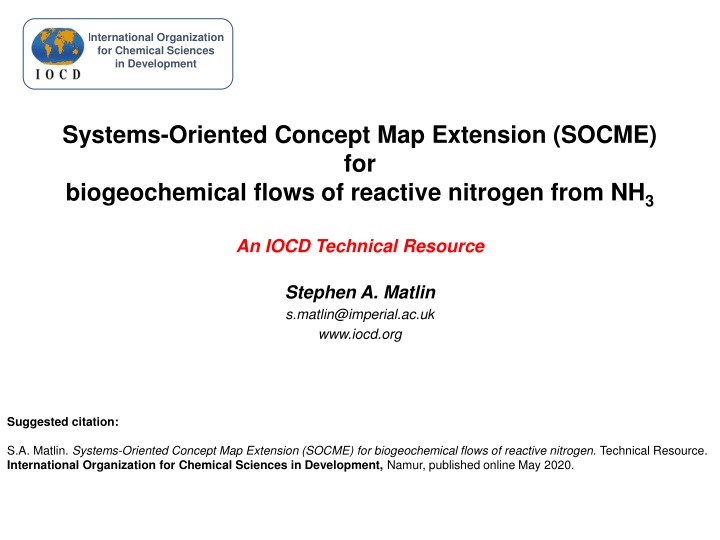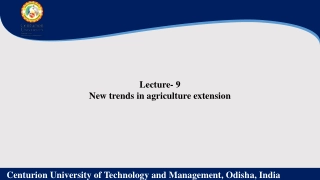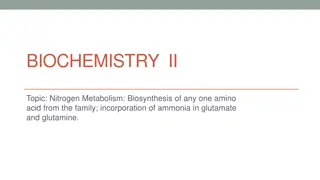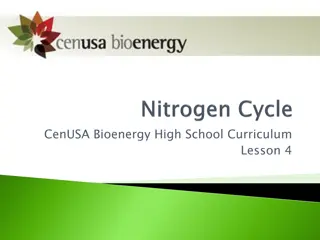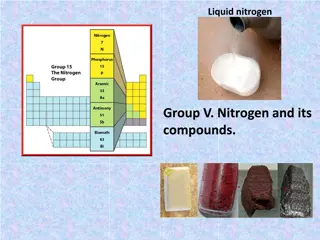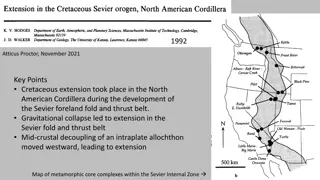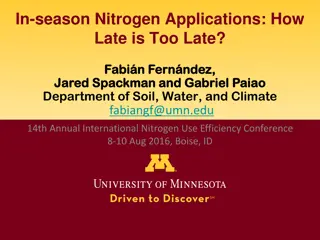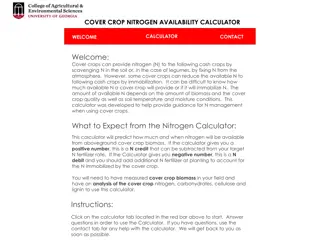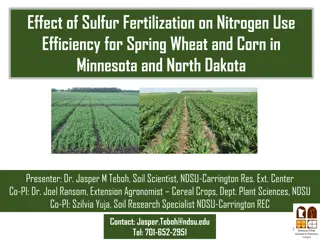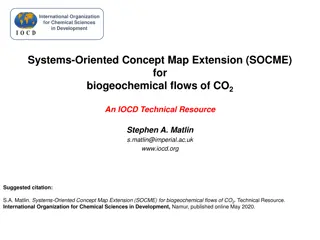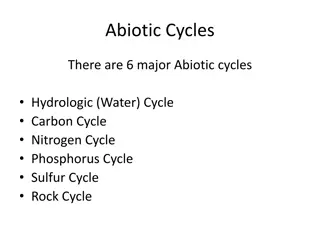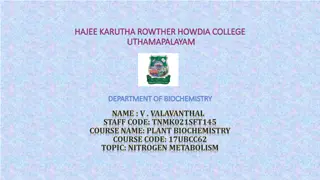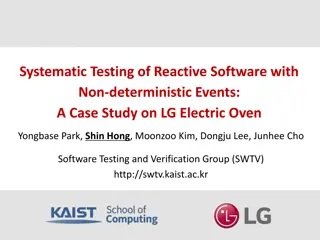Systems-Oriented Concept Map Extension for Reactive Nitrogen Flows
International Organization for Chemical Sciences in Development presents a Systems-Oriented Concept Map Extension (SOCME) focusing on biogeochemical flows of reactive nitrogen from NH3. The concept explores core reaction subsystems, energy input subsystems, equilibrium conditions, and the integration of chemical and energy inputs. It highlights the importance of Fe-based catalysts, high pressure requirements, and influences on ammonia reaction tendencies. Various chemical processes like the Ostwald process and the interconnected flows of nitrogen, hydrogen, methane, and carbon dioxide are also discussed within the comprehensive framework.
Download Presentation

Please find below an Image/Link to download the presentation.
The content on the website is provided AS IS for your information and personal use only. It may not be sold, licensed, or shared on other websites without obtaining consent from the author.If you encounter any issues during the download, it is possible that the publisher has removed the file from their server.
You are allowed to download the files provided on this website for personal or commercial use, subject to the condition that they are used lawfully. All files are the property of their respective owners.
The content on the website is provided AS IS for your information and personal use only. It may not be sold, licensed, or shared on other websites without obtaining consent from the author.
E N D
Presentation Transcript
International Organization for Chemical Sciences in Development Systems-Oriented Concept Map Extension (SOCME) for biogeochemical flows of reactive nitrogen from NH3 An IOCD Technical Resource Stephen A. Matlin s.matlin@imperial.ac.uk www.iocd.org Suggested citation: S.A. Matlin. Systems-Oriented Concept Map Extension (SOCME) for biogeochemical flows of reactive nitrogen. Technical Resource. International Organization for Chemical Sciences in Development, Namur, published online May 2020.
N2(g) + 3H2(g) 2NH3(g) Ho = -92; Go = -33 (kJ mol-1) CORE REACTION SUBSYSTEM Nitrogen (N2) Hydrogen (H2) Reaction Ammonia (NH3) REACTION CONDITIONS SUBSYSTEM
ENERGY INPUT SUBSYSTEM N2(g) + 3H2(g) 2NH3(g) Ho = -92; Go = -33 (kJ mol-1) CORE REACTION SUBSYSTEM Nitrogen (N2) Hydrogen (H2) Fe-based catalyst High pressure Reaction Application of Le Chatelier Principle High Reaction requires temperature Ammonia (NH3) Reaction tends towards Influence REACTION CONDITIONS SUBSYSTEM Equilibrium
CHEMICAL INPUT SUBSYSTEM ENERGY INPUT SUBSYSTEM Waste heat boiler Burned for energy Heater CORE REACTION SUBSYSTEM Compressor Hydrocarbon fuels Source of Produces Nitrogen (N2) Hydrogen (H2) Fe-based catalyst High pressure Reaction High Reaction requires temperature Ammonia (NH3) Reaction tends towards Influence REACTION CONDITIONS SUBSYSTEM Equilibrium
Connects to CO2 SOCME CHEMICAL INPUT SUBSYSTEM ENERGY INPUT SUBSYSTEM Up to 3.5t CO2 for every 1t NH3 OSTWALD PROCESS SUBSYSTEM Carbon dioxide (CO2) By- product Waste heat boiler Methane (CH4) Burned for energy Air Source of Heater Source of Synthesis gas: H2, CO, CO2, H2O from fossil fuels by steam reforming (high T, P) Source of CORE REACTION SUBSYSTEM Compressor Hydrocarbon fuels Source of Produces Nitrogen (N2) Hydrogen (H2) CH4 + H2O CO + 3H2 CO4 + H2O CO2 + H2 Fe-based catalyst High pressure Reaction High Reaction requires temperature Ammonia (NH3) Reaction tends towards Influence REACTION CONDITIONS SUBSYSTEM Equilibrium
CHEMICAL INPUT SUBSYSTEM ENERGY INPUT SUBSYSTEM OSTWALD PROCESS SUBSYSTEM Oxygen (O2) Carbon dioxide (CO2) By- product Waste heat boiler Methane (CH4) Source of Burned for energy Air Source of Heater Nitrogen dioxide (NO2) Source of Reaction Reaction Reaction CORE REACTION SUBSYSTEM Compressor Nitrogen monoxide Nitrogen monoxide (NO) (NO) Hydrocarbon fuels Source of Produces Nitrogen (N2) Hydrogen (H2) Water (H2O) Fe-based catalyst High pressure Reaction Nitric acid (HNO3) Reaction High Reaction requires temperature Ammonia (NH3) Reaction tends towards Influence REACTION CONDITIONS SUBSYSTEM Reaction Equilibrium Ammonium nitrate (NH4NO3) INTENDED USES SUBSYSTEM
CHEMICAL INPUT SUBSYSTEM ENERGY INPUT SUBSYSTEM OSTWALD PROCESS SUBSYSTEM Carbon dioxide (CO2) By- product Waste heat boiler Oxygen (O2) Methane (CH4) Source of Burned for energy Air Source of Heater Nitrogen dioxide (NO2) Source of Reaction Reaction CORE REACTION SUBSYSTEM Compressor Nitrogen monoxide (NO) Hydrocarbon fuels Source of Produces Nitrogen (N2) Hydrogen (H2) Water (H2O) Fe-based catalyst High pressure Reaction Nitric acid (HNO3) Reaction High Reaction requires temperature UNINTENDED CONSEQUENCES SUBSYSTEM Ammonia (NH3) Reaction tends towards Influence REACTION CONDITIONS SUBSYSTEM Reaction Equilibrium Ammonium nitrate (NH4NO3) Nitrification Denitrification Used in Leaching Immobilization Leads to Agriculture Explosives Volatilization Nitroglycerine Munitions Organic nitrogen INTENDED USES SUBSYSTEM Dynamite
Reactive NSOCME CHEMICAL INPUT SUBSYSTEM ENERGY INPUT SUBSYSTEM OSTWALD PROCESS SUBSYSTEM Carbon dioxide (CO2) By- product Waste heat boiler Oxygen (O2) Methane (CH4) Source of Burned for energy Air Source of Heater Nitrogen dioxide (NO2) Source of Reaction Reaction CORE REACTION SUBSYSTEM Compressor Nitrogen monoxide (NO) Hydrocarbon fuels Source of Produces Nitrogen (N2) Hydrogen (H2) Water (H2O) Fe-based catalyst High pressure Reaction Nitric acid (HNO3) Reaction High Reaction requires temperature UNINTENDED CONSEQUENCES SUBSYSTEM Ammonia (NH3) Reaction tends towards Influence REACTION CONDITIONS SUBSYSTEM Reaction Equilibrium Environmental nitrates Eutrophication Source of Ammonium nitrate (NH4NO3) Promotes Nitrification Denitrification Part of Used in Runoff Leaching Conflicts May end up in Immobilization Leads to Drinking water system Used in Agriculture Explosives Need to avoid Surface water Volatilization Nitroglycerine Munitions Organic nitrogen INTENDED USES SUBSYSTEM Such as Health effects Methemoglobinemia Dynamite
Reactive NSOCME CHEMICAL INPUT SUBSYSTEM ENERGY INPUT SUBSYSTEM OSTWALD PROCESS SUBSYSTEM Carbon dioxide (CO2) By- product Waste heat boiler Oxygen (O2) Methane (CH4) Source of Burned for energy Air Source of Heater Nitrogen dioxide (NO2) Source of Reaction Reaction CORE REACTION SUBSYSTEM Compressor Nitrogen monoxide (NO) Hydrocarbon fuels Source of Produces Nitrogen (N2) Hydrogen (H2) Water (H2O) Fe-based catalyst High pressure Reaction Nitric acid (HNO3) Reaction High Reaction requires temperature UNINTENDED CONSEQUENCES SUBSYSTEM Ammonia (NH3) Reaction tends towards Influence REACTION CONDITIONS SUBSYSTEM Reaction Equilibrium Environmental nitrates Eutrophication Source of Ammonium nitrate (NH4NO3) Promotes Nitrification Denitrification Part of Used in in Used Runoff Leaching Conflicts May end up in Immobilization Leads to Drinking water system Used in Agriculture Explosives Need to avoid Surface water Volatilization Nitroglycerine Munitions Organic nitrogen INTENDED USES SUBSYSTEM Such as Health effects Methemoglobinemia Dynamite
CHEMICAL INPUT SUBSYSTEM By- product ENERGY INPUT SUBSYSTEM ? Carbon dioxide (CO2) Water (H2O) Low temp catalyst Photolysis Source of Electrolysis CORE REACTION SUBSYSTEM Nitrogen (N2) Hydrogen (H2) Reaction control Reaction Reaction requires Ammonia (NH3) REACTION CONDITIONS SUBSYSTEM
ALTERNATIVE N DERIVATIVE SUBSYSTEM Carbon dioxide CO2 Urea Reaction CORE REACTION SUBSYSTEM NH2CONH2 Used in Nitrogen (N2) Hydrogen (H2) Reaction Agriculture Resins Explosives Ammonia (NH3) INTENDED USES SUBSYSTEM UNINTENDED CONSEQUENCES SUBSYSTEM
